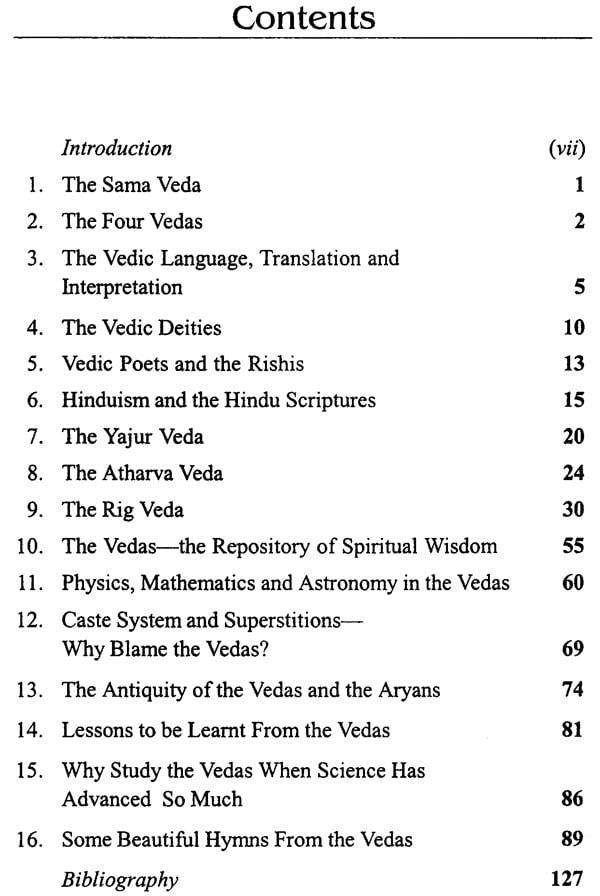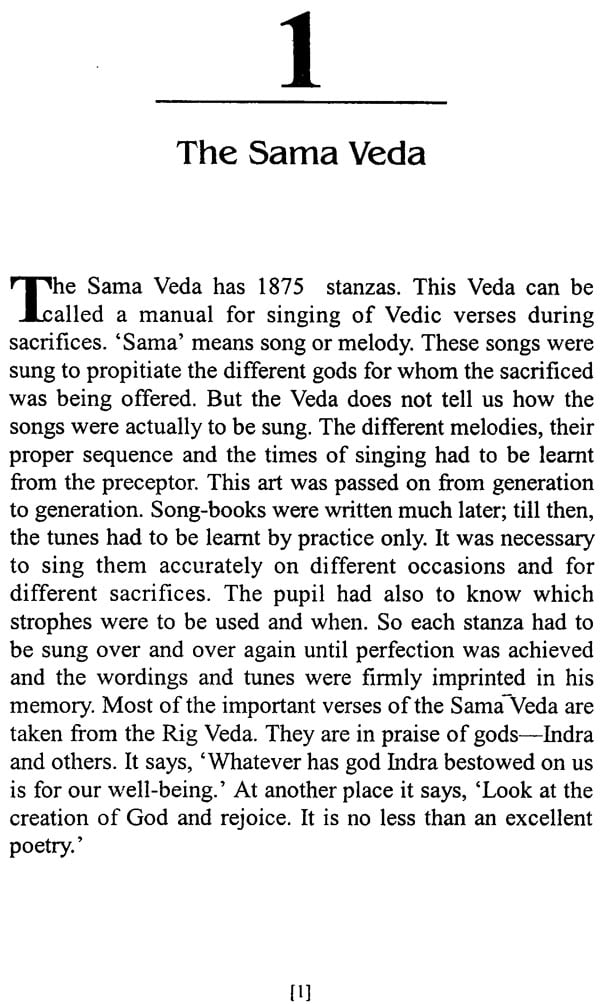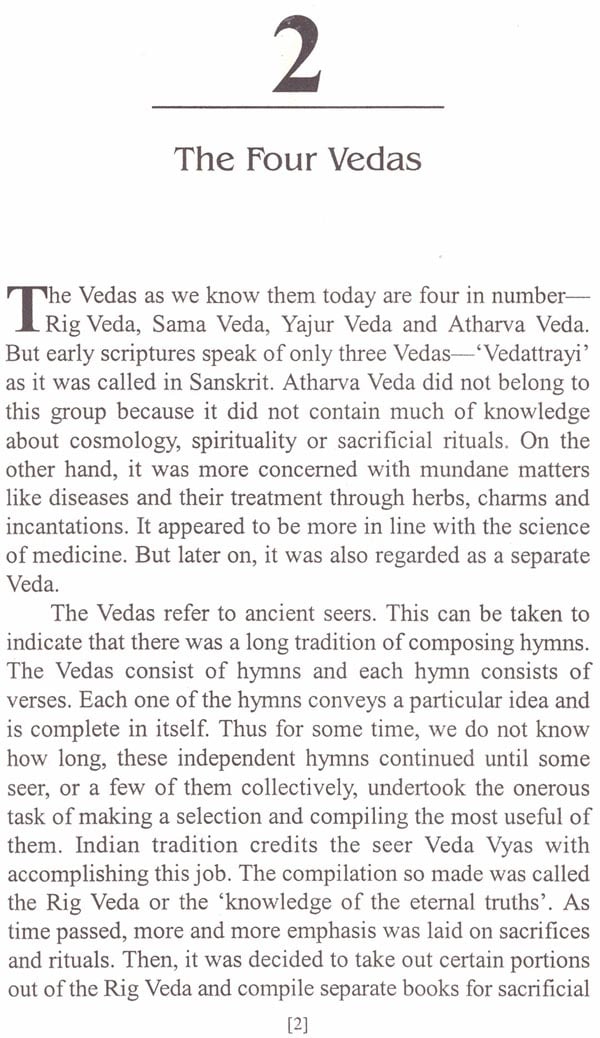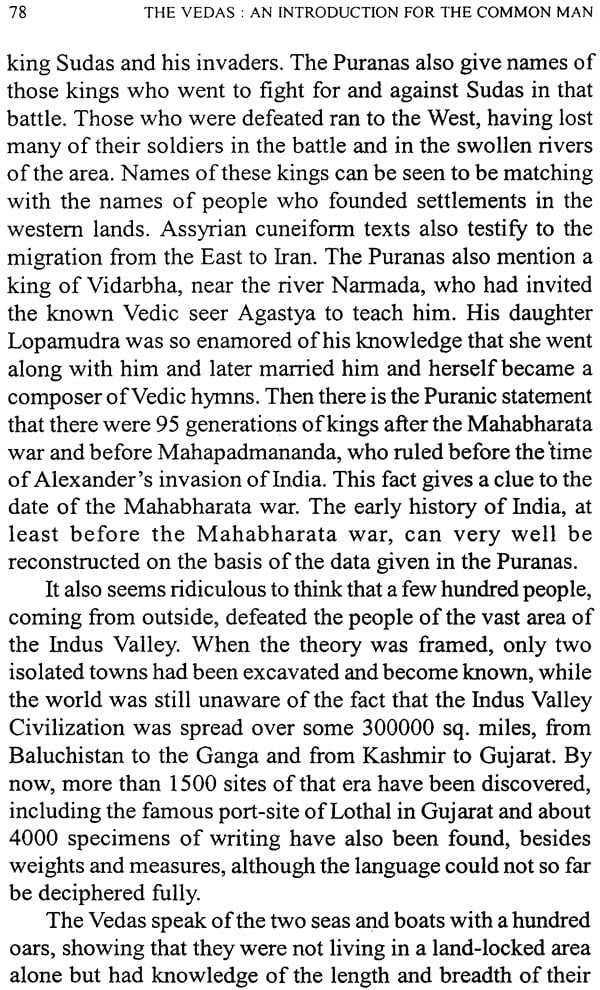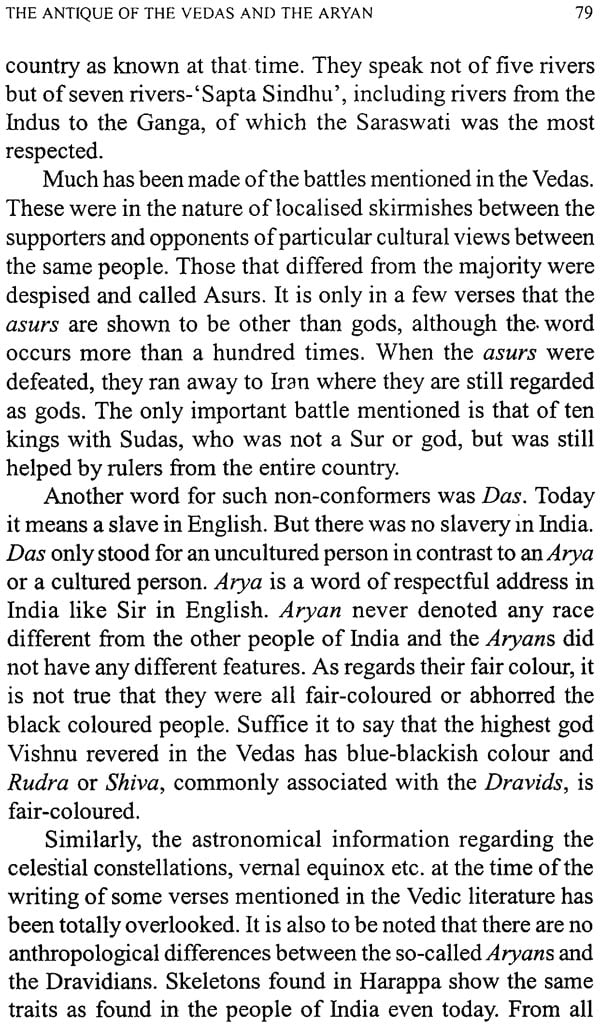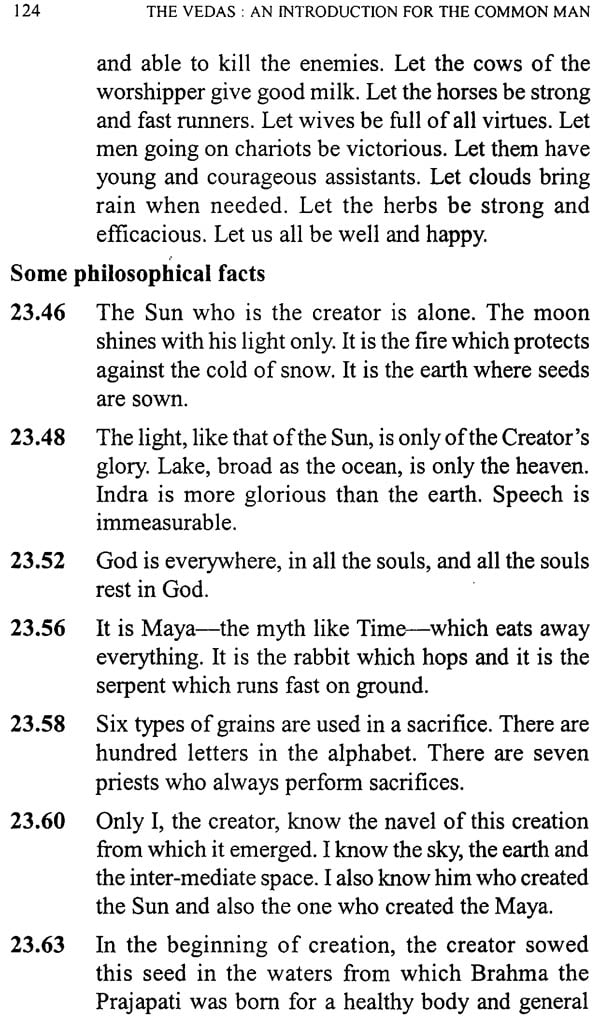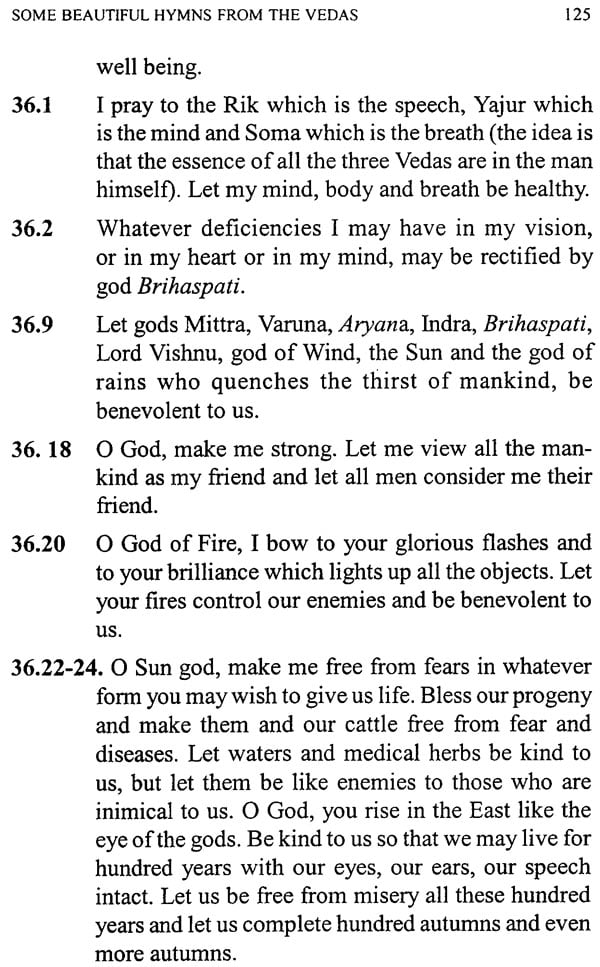
The Vedas
Book Specification
| Item Code: | NAT600 |
| Author: | R. N. Vaidy |
| Publisher: | Books India International, New Delhi |
| Language: | ENGLISH |
| Edition: | 2005 |
| ISBN: | 8189129171 |
| Pages: | 133 |
| Cover: | HARDCOVER |
| Other Details | 9.00 X 6.00 inch |
| Weight | 300 gm |
Book Description
The book seeks to present a brief introduction to the Vedas from the point of view of the common man? People of India are generally aware of the existence of the Vedas and regard them with veneration, but only few of them may have had an occasion to see them, much less read them. This book tries to tell them in brief and in a simple language as to what the Vedas contain and what they do not. It throws light on the various aspects of the Vedas-their authorship, their superb poetry, their various interpretations, scientific and astronomical studies related to them and the truth and spirituality contained in them. It also briefly deals with the Aryan question, i.e., the theory profounded by the old historians that the seers who wrote the Vedas had come from outside India and they demolished the Indus Valley Civilization, forcing the local people to migrate to the Dravid land.
The book shows how the Vedas are unnecessarily blamed for the present day evils of the Indian society, like caste rigidity, horrors of hell, too much concern for the other world while denying the present life etc. The Vedic seers, on the other hand, enjoyed life thoroughly, without taboos regarding food and dress and desired to live for a hundred years or more with active mental and both faculties, in peace with themselves and with me world.
Born in 1931 in Madhya Pradesh, R.N. Vaidya had a very brilliant academic career. He did Masters in Mathematics and then in Law. He joined the Indian Administrative Service and after a distinguished career, became Member of the M.P. Public Service Commission.
But his main interest has always been Sanskrit literature and ancient Indian history and culture. His first book, about the Puranas, was published by Bharatiya Vidya Bhavan, Mumbai and the second, on the story of Rama in different Indian languages, was published by Bhuvan Vani Trust, Lucknow.
While in USA this time, I came across an article in the fortnightly `India Abroad' popular among Indians, about the treatment Hinduism gets in the History classes in USA. The article was written by a girl who had herself studied this in classes 6th to 10th. She said that in the school textbooks, Hinduism is summed up in a few lines, such as : "Hindus worship more than 2000 gods. They worship snakes, cows and trees and bathe in the same over-polluted river in which they immerse their corpses and ashes of their dead. Their cows are allowed to roam about in the streets, blocking all traffic." Then I read a book written by Ed. Viswanathan, which is in a question-answer form, entitled "Am I a Hindu? The Hinduism Primer". Without in any way belittling the utility of the book, I am constrained to say that I was taken aback when I learnt information like this, being imparted to Hindu children, "During the Rig Vedic period, the Aryans were constantly engaged in battles, and drinking and gambling were part and parcel of their culture. Those who drank liquor (Sura) were called Sur or gods, and those who refused to drink were called Asur (Ch.1)...In Sat Yug, children were born by mere wishing and men lived for 4000 years, in Treta, they were born by touch, and men lived for 3000 years, in Dwapar, sexual intercourse was allowed and men lived for 2000 years, while in Kali Yug (the present), homosexuality also started, men will live up to 100 years, women will rule and there will be no truth or righteousness" (Ch.78). If this is the knowledge we impart to our children, how can we blame the foreigners if they make remarks about our religion which are not palatable to us? The fact is that our own knowledge in this matter is very limited. We blindly believe in the rituals and traditions which were laid down long ago and fail to examine them rationally. In the present days of science, if a teenager learns this, he naturally believes that our religion is a great hoax. Therefore, it is our duty to read the scriptures carefully, find out what is rational and stands to commonsense and what is not, and explain to our children accordingly and thus enable them to face the criticism heaped on them by their peers and teachers. Hinduism has a large number of scriptures, which evolved over thousands of years. Of them, we need to study at least the Vedas, the principal Upanishads and some of the early Puranas, like Vayu, Koorma etc. Then alone can we view Hinduism in its pristine glory and see how the growth of myths and traditions has clouded it.
Unfortunately, there is a great dearth of unbiased books and much of what is available in print today is based on the views of the ardent devotees, who have blind faith in these rituals, myths and traditions of Hinduism and do not consider it necessary to examine them rationally.
Hinduism has its roots in the Vedas, which are our most important scriptures. They are the oldest available literature of the world. Scholars in the West are now coming round to the traditional Indian view that the Rig Veda, the oldest Veda, is at least 5000 years old. And it is the oldest preserved scripture which has been passed on to us through so many centuries by faithful oral tradition even in the absence of paper and printing. Egyptian civilization has left for us the Pyramids that have been eroded by inclement weather and their marble and gold stolen by thieves. The Babylonian civilization is gone without a trace. But the Vedas are like mental pyramids that have shaped the spiritual beliefs of the crores of Hindus through the ages. No Hindu scholar, no section of Hinduism can deny this connection. Although other scriptures and mythologies have over this long period of time brought so many changes in the practice of Hinduism that today our traditions are far different from the Vedic ideals, all these later scriptures have always taken shelter behind the authority of the Vedas. These traditions might have been useful at some time but seen today, they appear to have created class distinctions in Hindu society, based on caste, gender and profession, which have had very pernicious effect on our growth. India's poverty and unemployment is in no small measure due to misplaced emphasis on some of these traditions. They have led to the erosion of the dignity of labour in India. We see large-scale unemployment but there is also disinclination to learn skills for manual work. Too much emphasis on a male child, nurtured by fear of a terrible hell in the absence of a son, led to avoidable increase in population, and hence the poverty. While the Vedic people yearned for a healthy long life of hundred years, later scriptures declared that life itself is a torture and the sooner it ends the better. Rituals for release from the cycle of birth and death gained prominence over social work. Study of the Vedas is, therefore, necessary to see how this new structure was created, replacing the old ideals.
Importance of the study of the Vedas suffered in India mainly because printed copies were not available before the 19th century. Also, they were supposed to contain only spiritual matters, so sacrosanct that anybody other than the priests could not even touch them. In fact, they had come to be treated as the exclusive property of some families of priests and so far as the common man was concerned, he had to be content with what they declared to be the Vedic tenet. All sorts of codes of conduct and mythological stories were passed on in the name of religion. Fear of terrible hell to the departed soul created a whole set of new rituals. All these had no place in the Vedas, though they were perpetuated in their name. It is, therefore, essential for our own good to know what the Vedas really say and what they do not, for then alone can we satisfy our critics. Even for the survival of the Hinduism, it is necessary for us to explain the reality to our children who have to contend with a critical world. Times are changing fast and no society can cope up with the new challenges unless it gains inner strength. A study of the Vedas becomes important in this context. This book is a modest attempt to present some salient features of the Vedas in a nutshell.
The Vedic literature is vast and the early Sanskrit language in which Vedas are written is not very easy to understand. Moreover, many of the words used can have multiple meanings. In addition to spiritual urges, lofty principles of modern Physics and Astronomy are also found hidden behind their plain words. But so far as the common reader, for whom this small book is intended, is concerned, he can find, even without such deep study, enough material to appreciate the beauty of the Vedic verses and sublimity of their ideals. Scholars today realise that the Vedic teachings have an eternal value for the whole world. In the Western countries, besides the lectures of enlightened Hindus, such as followers of Swami Vivekananda and the scholars of the Chinmaya Mission, need for Yoga and meditation has aroused interest in the wisdom of the ancient Indian seers and people are eager to know what is written in our scriptures. Unfortunately, some history books in India contain old notions that the Vedas were written by nomadic people who came to India with chariots and horses and plundered the towns and villages of the Indus Valley Civilization, which had already developed sufficiently to produce town-planning marvels as seen in Harappa and Mohanjodaro. The book is intended to provide some light in this direction also so that such misconceptions may be removed to some extent and readers may draw their own conclusions.
I am fully conscious of my limitations and readers are requested to bear with me. As far as the text is concerned, it is based on my own reading of the original scriptures and the guidance received from the various books named in the Bibliography. I express my heartfelt gratitude to the authors of these books from which I have immensely benefitted. Detailed philosophical discussions, system of sacrifices described in the Yajur Veda and the songs to be sung at such sacrifices as also the chants, incantations, diseases and herbs mentioned in the Atharva Veda are clearly outside the scope of this book. I have not given citations or footnotes because the book is meant only for the beginners. Only a general picture of the contents of the Vedas has been presented but glimpses of the various other important aspects of the interpretation of the Vedas have also been given in brief so that those who may be interested may go for detailed studies of these aspects of the Vedas.
**Contents and Sample Pages**
